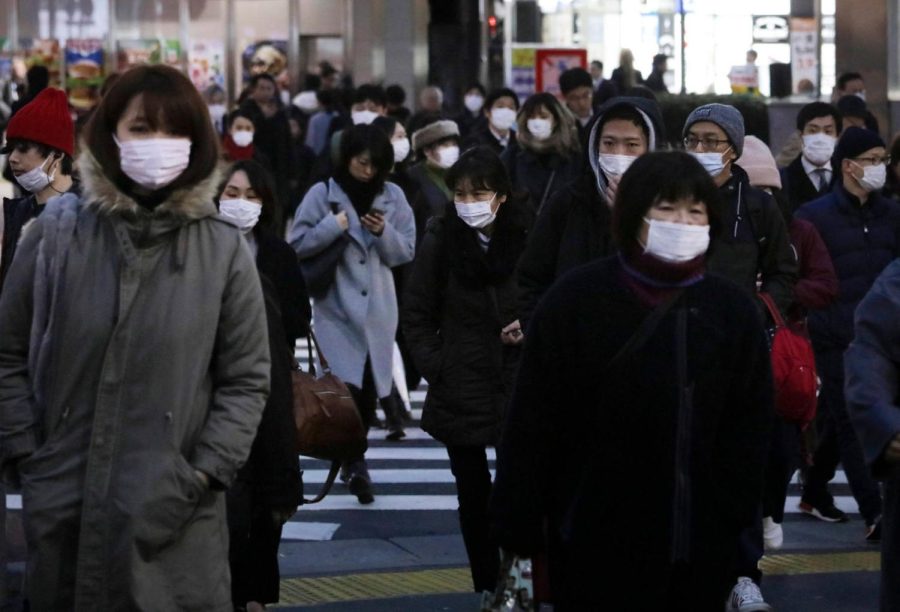Wuhan Coronavirus Outbreak Worries Travelers as Death Toll Continues to Rise Quickly
Pedestrians in Tokyo wearing protective masks. Courtesy of New York Times
Pedestrians in Tokyo wearing protective masks.Courtesy of New York Times
January 28, 2020
The international outbreak of a respiratory illness caused by a novel coronavirus, named 2019-nCoV, in recent weeks has sparked concern across the globe as more have become infected and officials scramble for information. As of 7 p.m. on Tuesday, Jan. 28, according to the New York Times, five cases have been confirmed in the United States, the death toll has risen to 131 and over 3000 cases have officially been reported in China, the source of the virus.
The outbreak began in Wuhan, China at a market selling live animals and seafood. It was first reported by the Chinese government on Dec. 30 after about 60 people became infected with a mysterious pneumonia-like disease. The illness was then linked to a new coronavirus by Chinese researchers on Jan. 9. Animals are most likely the source of this new coronavirus, but it is still unclear which animal is the culprit. Similar diseases like SARS (Severe Acute Respiratory Syndrome) and MERS were first transmitted by animals in the case of MERS (Middle East Respiratory Syndrome), but evidence is suggesting that this Wuhan coronavirus is also being transmitted from person to person.
Coronaviruses are named for the spikes atop their membranes that resemble the sun’s corona, the Latin word for crown. They cause respiratory illnesses to humans, as well as infect animals, and the Center for Disease Control and Prevention (CDC) website states that most people become infected with some types of coronaviruses during their lifetime. Many coronaviruses are associated with the common cold and symptoms last for a short period with low to mild severity, but they can cause pneumonia and bronchitis for those with weakened immune systems, says the CDC.
Chinese officials first shut down transportation to Wuhan, then extending the ban to nine other cities, affecting 35 million people in total, according to WebMD. This came right before one of the busiest travel times in the region with the start of the Lunar New Year on Jan. 25, a widely celebrated holiday throughout China, a factor that certainly pushed officials to push containment efforts early. The CDC has issued a Level 3 Travel Health Notice, alerting travelers to avoid nonessential travel to China, and all passengers on direct and connecting flights from Wuhan will be diverted to one of five major US airports to undergo passenger screening upon entry.
“While the CDC considers this is a very serious public health threat, based on current information, the immediate health risk from 2019-nCoV to the general American public is considered low at this time,” CDC website states. “Nevertheless, CDC is taking proactive preparedness precautions.”
However, much is still unknown about this novel coronavirus and many officials as well as citizens around the world are concerned for the coming weeks. This outbreak is worrisome to many because of the Chinese government’s handling of the SARS epidemic in 2002 and 2003, whose cover up attempts delayed the response needed. China has promised more transparency for the 2019-nCoV outbreak and the World Health Organization has publicly appreciated their cooperation with scientists, the New York Times reports.
“When we get a new infectious disease, we learn about the most severe cases first, the top of the pyramid as it were,” Dr. William Schaffner, a professor of infectious diseases and preventive medicine at Vanderbilt University Medical Center said. “As the investigation goes on, we often learn there are less severely infected people, and even people who are infected who don’t get sick at all.”
Public health experts are warning against mass anxiety, but still the CDC is urging people to get flu shots, wash their hands thoroughly and stay home if they are sick to reduce the spread of illness. This is a rapidly evolving public health issue, and organizations across the globe are working together to aggressively continue accessing and monitoring the situation to provide current information on the 2019 novel coronavirus and reduce its impact.












